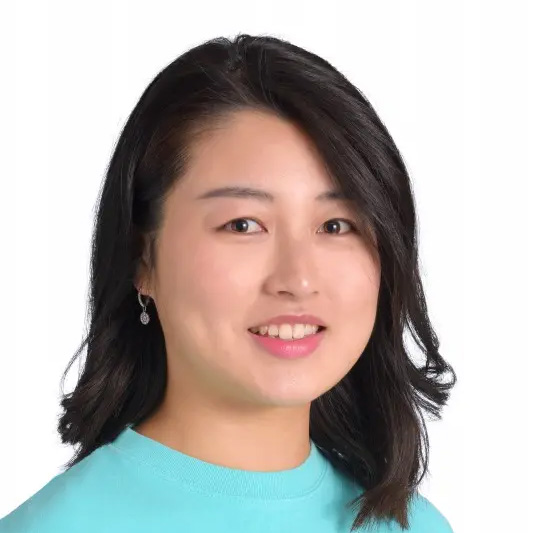IB PYP UOI Class Introduction (5-year-old) Vol.1 - Preschool at CGK International School
CGK International School has been fully implementing the International Baccalaureate (IB) curriculum since April of this year. What is the IB? IB is a truly wonderful educational policy that is so profound that it is impossible to describe in just a few words. If I could give you one simple explanation, it would be that IB education is not what is commonly referred to as a "lecture style," where the teacher stands in front of the students and gives them the answers to their questions.
In my five-year-old class, the teachers are constantly thinking about how to develop the children's passions and new interests, and how to connect them to the content of the IB's Unit of Inquiry (UOI). The children's curiosity and imagination are so rich, and their flexible thinking amazes us as adults every day. For example, when children discover something new that they have never experienced before, they are very good at connecting it to similar events and knowledge that they have acquired in the past, and they quickly absorb it as their own experience. Children casually make comments that may surprise adults, and teachers are often taught by children. When I encounter such moments of discovery and excitement that come from daily conversations with the children, it is a moment when I am once again glad to be a preschool teacher at CGK.
The wonderful thing about IB is that we can think flexibly about the curriculum from the children's point of view. We try to think about how we can develop the children's spirit of exploration, rather than thinking in terms of adult convenience or guiding the children in a way that is easier for adults.
This year’s Sky (5-year-old) students are experiencing the new curriculum of IB’s Unit of Inquiry (UOI),
“Where We Are in Place and Time”
for the first time with tons of curiosity and questions. The central idea we wanted to convey from this particular unit was,
”Everyone has their own roles and responsibilities in their community”
This may sound a bit difficult for 5-year-old children to understand but in fact, it was the exact opposite.
Background for choosing this Central Idea
- CGK International School has expanded to two buildings with the opening of its Kannai Campus in April of this year. The 4-year-old and 5-year-old classes have moved to the Kannai Campus. Sky class had originally spent their first two years of school at the Bashamichi Campus until last March. From April, their new school life began.
- In this new environment, we thought it would be the best time to learn not only about CGK, but also about the Yokohama community that we belong to. This also provided a good opportunity for us to consider how each individual is connected with one another within our community.
- Since CGK is filled with different educational pathways, we wanted to provide our students with opportunities to explore those pathways, identify which options they’re most interested in learning, and create a more interactive, collaborative environment between departments (e.g. Preschool / Elementary School / Afterschool). We wanted to start by making the children aware of their respective roles in the Sky classroom and within CGK. Beyond that, we would like to make sure that they naturally see this familiarity with Yokohama and other communities.
- Additionally, our goal was to help children learn and develop the characteristics of effective and great teamwork. In order to create a successful team, they needed to identify their own roles, responsibilities, and objectives. We want them to realize that they themselves already belong to various communities, and by properly considering and carrying out their roles and responsibilities, we want to connect them to the concept of being helpful to those around them.
Below are some of the experiences and skills the children acquired through these activities that fall in line with our central idea - Everyone has their own roles and responsibilities in their community.
Welcome to Sky Class!
The children were moving up to the oldest class and their hearts were filled with anticipation. However, they were in a new school building, in a new class, with new teachers. At first, there were no rules or routines in the class. One time in Sky class, the children enjoyed their free time with their friends, and for a while it was difficult for them to switch their mind between play time and lesson time. Of course, it is most important for children to enjoy their school life. But at the same time, school is a place where they can learn how to live in a group. We believe it’s equally important for children to listen attentively to others, speak in a positive manner, and of course, have fun building relationships!
Therefore, we asked the children, "What do you think we should do to make everyone feel comfortable at CGK? Do you have any good ideas?" The children came to the conclusion that we should make class rules that everyone agrees with. When I heard this, I was convinced by the "everyone agrees" part.
Sky's Essential Agreement
Now, the children have started to create their own rules and expectations for Sky class. Various opinions were expressed here. During one of our Japanese classes, we set up a table to discuss ideas for creating class rules as part of our Learning Center* activities. The ideas that came out of the table were "Be kind to others", "Be punctual", "Listen to others", "Use your words", "Silly time and serious time", etc. The children wrote down letters and drew pictures in their sketchbooks of the rules they came up with.
*Learning Center: An activity that enables transdisciplinary learning and provides a great opportunity for students to focus on areas that challenge them. They can practice skills they’ve already been taught in class, demonstrate responsibility and independence, and still be able to learn through play.
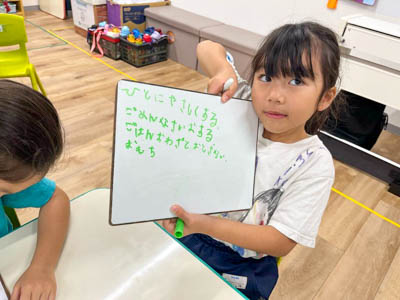
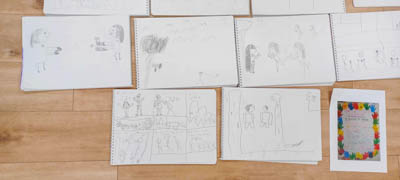
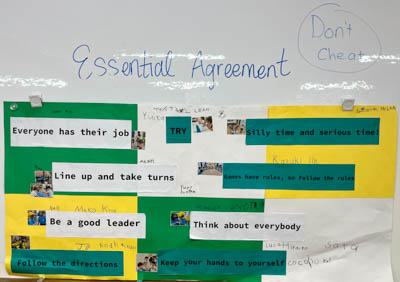
Later, the children presented the rules they came up with in front of everyone during English time. Of the many rules they created, the children voted on the rules they’d like to adopt for their classroom contract using counting toys (GSTAR). Once the final rules were decided upon by everyone, they assembled the rules onto construction paper and acknowledged their understanding of each rule by “signing” the paper. The contract was complete! The children did not simply follow the rules set by the teacher, but they decided them based on their own collaborative ideas. The children were also encouraged to take on individual roles in the class (e.g., wiping tables before lunch, sweeping the floor, wiping sinks, leading the group on walks, etc.). The first step in learning about community and teamwork was through the formation of what we now refer to as our “Essential Agreement”.

Scavenger Hunt Time!
The Sky Class had the opportunity to participate in a scavenger hunt at Yamashita Park, a place where they usually go to play casually. On this day, the children were divided into four teams of six and their roles were pre-assigned. This learning experience enabled them to gradually think about their own roles and responsibilities in their school community, home community, social community, etc.
Each team member had an important job in order to meet the goal of finding 12 specific objects in the park and then snapping pictures of all 12 objects within a matter of 30 minutes. Therefore, it was essential for them to communicate well with each other and listen to their friends' ideas. Each member was assigned the following roles: someone who deciphered the clues, a photographer (i.e. this person took photos of the exact location the clues were found), a timekeeper, a navigator (i.e. this person used a map to guide their team to each location), and most importantly, the team leader. Without each of these key components moving together as one, it would’ve been a difficult task to complete within the 30 minutes.
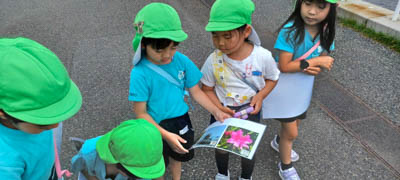
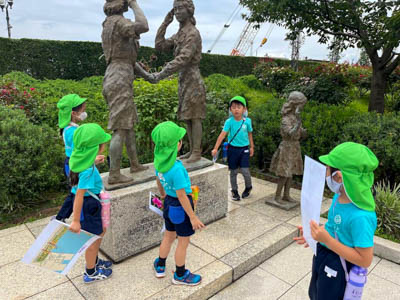

As a result, most teams were able to take all 12 pictures in the allotted time frame. However, I feel that this experience gave the children a valuable lesson of working together as a team. Although one group couldn't meet their goal, instead of saying, "We couldn't do it", they were discussing better ways they could have taken all the pictures within the allotted time. Through the experience of not being able to complete this mission without everyone’s full cooperation, the children realized the importance of teamwork. As a teacher, I would be happy if, when these children become adults, they suddenly remember the importance of working together in a community to achieve their goals.
Every teacher has their own roles and responsibilities in CGK
One day, when we laid out the photos of the teachers from each campus. We could clearly see from their attire in the photos that Kannai Campus has 3 different programs ranging from preschool, elementary, and afterschool. The preschool department is divided into two age groups: Mountain (4-year-old) and Sky (5-year-old) classes. In fact, this was the first time I properly used the word "community" here.
I asked the children, "Regardless of whether it is a large group or a small group, people come together in various ways at CGK. Is it a little difficult to understand what we mean by community?”
Surprisingly, one student answered "I understand. It's a group of people who like the same things and get together, isn't it?” Then another child said, "Yes, yes. For example, if we like the same anime, it doesn't matter if there are 100 or 10 of us, we are all in the same community, right?”
I was pleased to see that the children understood the concept of community better than I had expected.
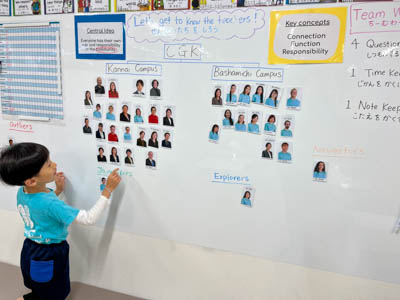
As Sky class began to rethink what community means to them, a new challenge began. It was to interview teachers at the Kannai Campus. The children came up with the content of the interviews themselves. The purpose of this project was to engage with teachers not only from our preschool department, but also Elementary School, After School, and even our administrative staff. We wanted to bring visibility to the variety of roles and responsibilities that make up CGK. At first, some of the children seemed a little nervous when talking to teachers they had never talked to before, but they started to learn and become comfortable with the roles of being a Timekeeper, Note-taker, Questioner, and how that connected to their learning experience at CGK. They learned to cooperate as a team, just like in the treasure hunt activity in Yamashita Park.
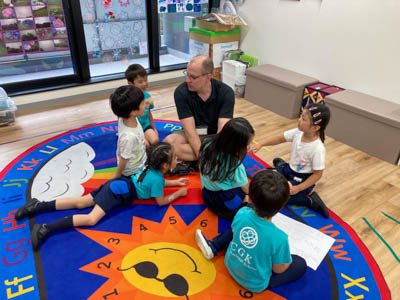
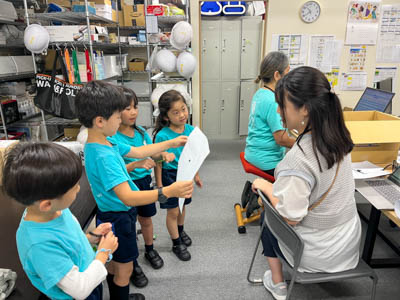

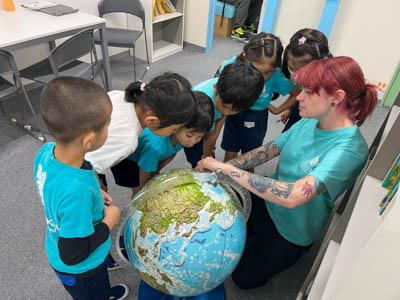
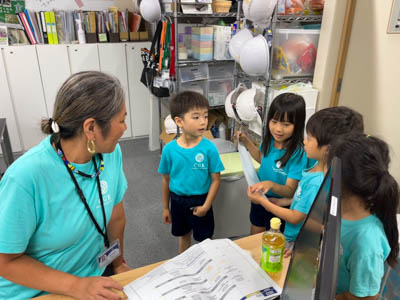
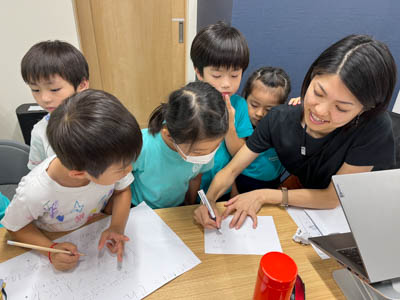
After the interviews were over, Sky students compiled the information acquired from the CGK teachers and created a profile book for each of them. The students were seen carefully writing each word, erasing any mistakes they had, and most importantly, continuing their efforts to finish their profiles. The completed profile books were displayed on each floor at the CGK School Festival held in July. I heard some children saying to their parents, “It was a lot of work, but I did my best!”. I was very happy that this activity had given the children a sense of accomplishment.
After completing this Teachers' Interview, Sky class applied the interview experience to their own situation and began to think about what a community means to them and what their role is within that community. They seemed to have learned through this interview activity that communities are small or large, and each person has an important role to play.
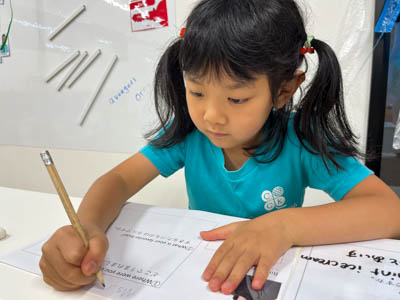
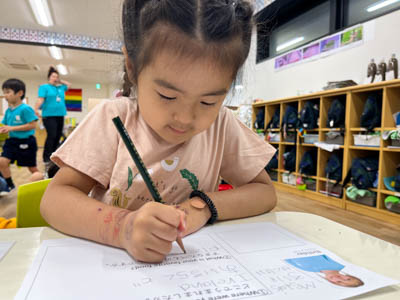
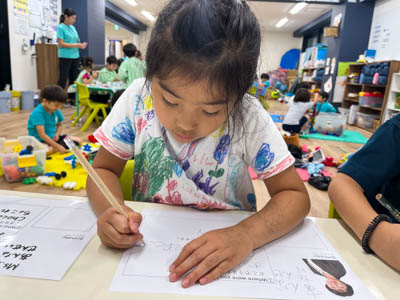
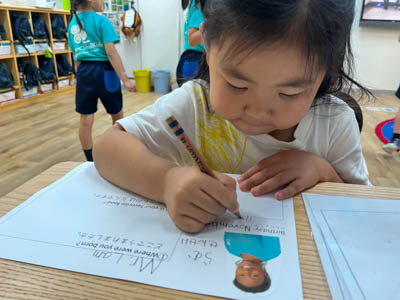
Roles and responsibilities within my community
At the end of the unit, the children were asked to freely express how we are all connected, what roles we play, and what responsibilities are given in order to meet a common goal. They were given a large piece of cardboard with nothing on it. I told them to “create a community" without giving too many details on what I expected from this new art project. In no time at all, the children were drawing pictures of Sakuragi-cho, Minatomirai, areas of Kannai that are familiar to them, and even included members you would typically find within a community (e.g. store clerks, train staff, teachers, students, etc.).
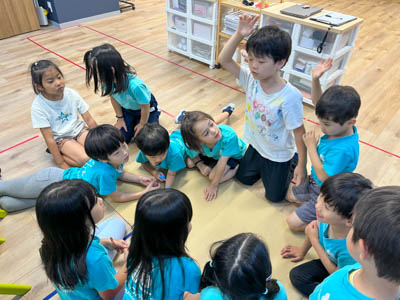
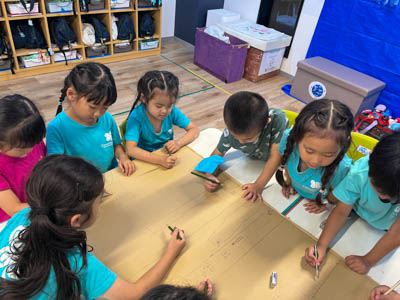
When the drafting was finished and the coloring was done using paint pens, some of our little artists would say, "I'll paint here, please paint over here! What color should I use here?" "Would it look more community-like if I wrote everyone's name?" They were sharing their opinions as they painted. Meanwhile, some of them said, "Welcome! We are a pen shop!" "Can I have a blue pen, please?" "Here you go! Please return the pen when you are done!". Before we knew it, they naturally came up with different roles from this “pen shop”. They lent out the pens and cleaned them up once they came back.
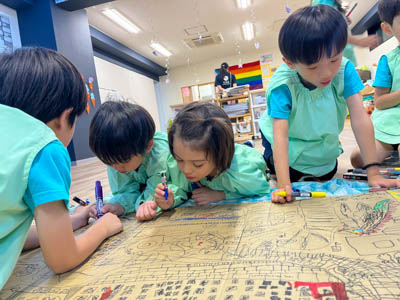
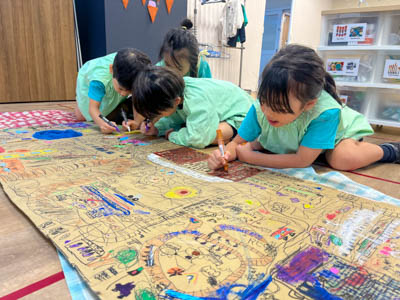
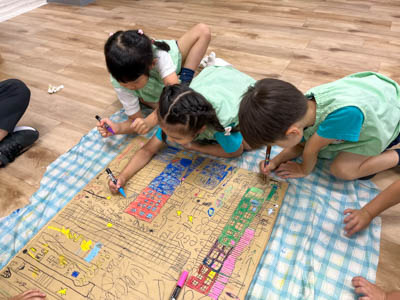
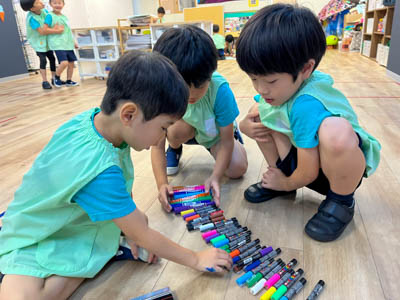
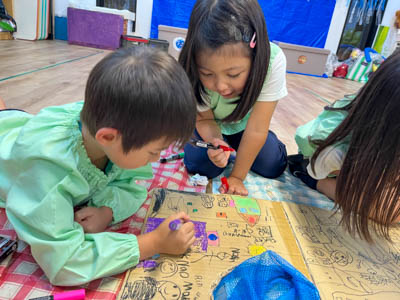
After experiencing the treasure hunt, interviewing teachers, and expressing their own community on the cardboard, Sky class talked again about what community means to them. Among the pictures that everyone drew on the cardboard, CGK was drawn. The children understood the concept of community in their own way, saying, "In this CGK, there are many teachers, elementary school, after school, and various groups.” "Not only in CGK, but also in the Red Brick Warehouse and the Landmark Tower that we drew, there are many different types of people, jobs, and stores”. The children seemed to understand the concept of community, member roles, and the responsibilities that come with it. At the end of the class, everyone looked around at the teacher profiles and the community pictures that each student had worked so hard to complete, and the Sky class enjoyed the sense of accomplishment of having worked through this unit.
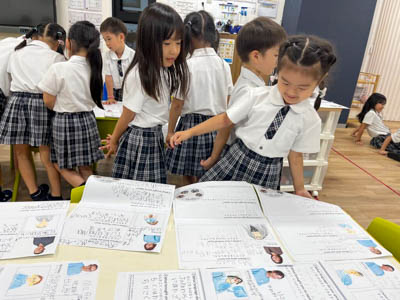
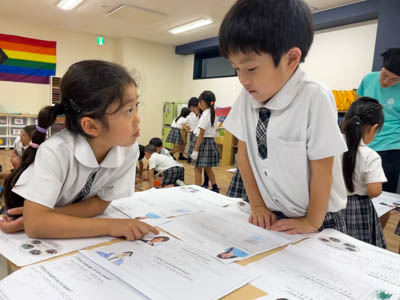
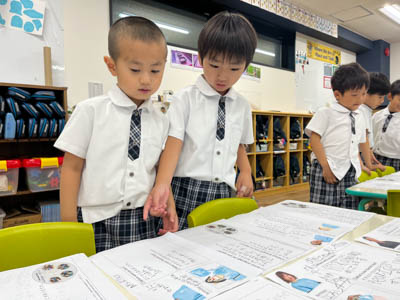
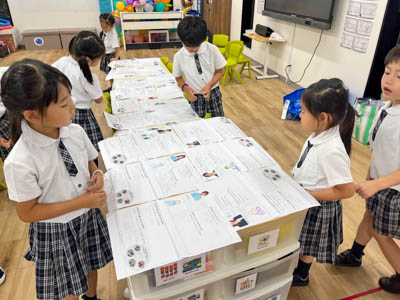
For our next UOI, the children will be diving into a new theme called "How the World Works", which highlights a lot of science-related topics. What kind of activities will they be engaged in to deepen their learning and expand their knowledge? We will keep you posted on their progress!
Author Profile
-

-
Maya - Preschool Teacher (Japan)

Preschool homeroom teacher for 5-year-old class at CGK International School.
Major in Asian Studies at American University in Japan. 3 years experience at an international preschool in Yokohama (experienced homeroom teacher for 2-5 year olds, and head teacher duties).




















